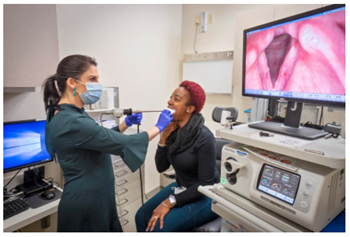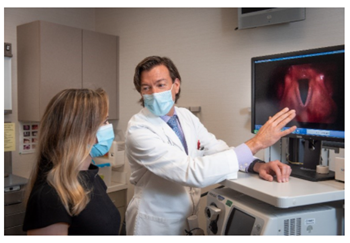 Rigid Video Laryngostroboscopy
Rigid Video Laryngostroboscopy
The first way to examine your larynx is through trans-oral rigid video laryngostroboscopy. This involves inserting a small rigid camera scope to the back of your mouth to look down at your larynx. The camera scope is attached to a stroboscopic light source, which allows us to capture a slow motion video of your vocal fold vibration when speaking. This procedure helps detect subtle abnormal findings that result in your voice problem. During the exam, you will be asked to perform a variety of tasks including breathing, holding out an “e” sound, pitch glides, and other assessments.
Flexible Video Laryngostroboscopy
The second way to evaluate your larynx is called trans-nasal flexible video laryngostroboscopy. In this evaluation, your doctor or speech-language pathologist will insert a very thin, flexible camera scope through your nose and into your throat. The camera scope is attached to a stroboscopic light source, which allows us to capture a slow motion view of your vocal fold vibration while you speak or sing. During the exam, you will be asked to perform a variety of tasks including breathing, holding out an “e” sound, pitch glides, and other assessments. If you are having problems with your singing voice, you may be asked to sing during the exam.
 How to Prepare for Video Laryngostroboscopy
How to Prepare for Video Laryngostroboscopy
Video laryngostroboscopy is a straight-forward in-office procedure that does not require anesthesia or special precautions. You do not need to do any preparation prior to these tests. If you undergo flexible video laryngostroboscopy, topical numbing gel or sprays may be used to increase comfort. The video exam will only last around 1-2 minutes. Our team will record the exam and review the findings with you during your office visit.
